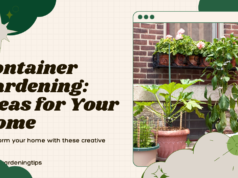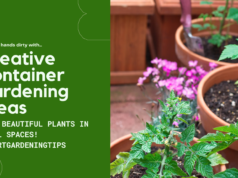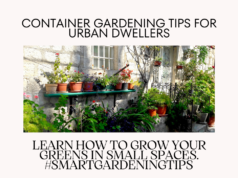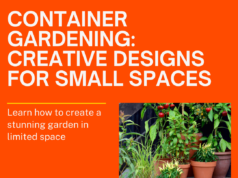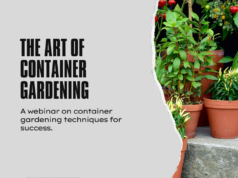
Welcome to the ultimate container garden maintenance guide! Whether you are a seasoned gardener or just starting your green-thumb journey, this guide is here to provide you with essential tips and advice for keeping your container gardens thriving. From selecting the right pots to seasonal maintenance, we’ve got you covered!
Container garden care is crucial for ensuring the health and longevity of your plants. By understanding the best practices, you can create a beautiful and vibrant garden space that will bring joy to your surroundings. So, let’s dive in and discover how to care for your container garden like a pro!
Key Takeaways:
- Proper container garden maintenance is essential for the health and growth of your plants.
- Choosing the right pots based on the type of plants is crucial for their well-being.
- Seasonal maintenance ensures your container garden thrives in changing weather conditions.
An Overview of Container Gardening
Welcome to the world of container gardening! Whether you have limited outdoor space or simply enjoy the convenience of gardening in containers, container gardening offers a wealth of benefits. In this section, we’ll explore the advantages of container gardening and why it’s worth maintaining for both seasoned gardeners and beginners alike.
Flexibility and Versatility
One of the key benefits of container gardening is its flexibility. Unlike traditional gardening, container gardens can be easily moved and rearranged to accommodate changing needs. This allows you to experiment with different layouts, create stunning focal points, and even bring your favorite plants indoors during extreme weather conditions.
| Benefits of Container Gardening |
|---|
| Flexibility: Easily rearrange and move containers for a versatile garden. |
| Space Optimization: Perfect for those with limited outdoor space or no access to a garden. |
| Enhanced Creativity: Let your imagination run wild with unique container designs and arrangements. |
| Accessibility: Ideal for individuals with mobility issues as containers can be placed at a comfortable height. |
| Seasonal Adaptability: Protect plants from harsh weather conditions by moving them indoors or to sheltered areas. |
| Pest Control: Containers can help prevent pests and invasive plants from spreading throughout the garden. |
Space Optimization
Container gardening is a perfect solution for those with limited outdoor space or no access to a traditional garden. Whether you live in an apartment or a house with a small yard, containers allow you to maximize your gardening potential. Balconies, patios, and even windowsills can be transformed into lush garden areas with the right selection of containers and plants.
Enhanced Creativity
Container gardening provides endless opportunities for creativity. With an array of container types, sizes, and materials available on the market, you can experiment with different textures, colors, and styles to create unique and visually appealing arrangements. Let your imagination run wild and design a container garden that reflects your personal taste and style.
Choosing the Right Containers
When it comes to container gardening, selecting the right containers is crucial for the health and growth of your plants. Different types of plants have varying needs, and choosing the appropriate size and material can significantly impact their overall well-being. In this section, we will explore the various types of containers available, suitable for different plant varieties, and provide valuable tips for selecting the perfect size and material.
Types of Containers
Container gardening offers a wide range of options to suit your plant preferences and space constraints. Here are some popular types of containers to consider:
- Clay Pots: These classic containers are not only aesthetically pleasing but also provide excellent moisture regulation for your plants.
- Plastic Containers: Lightweight and durable, plastic containers are ideal for outdoor use and come in various shapes and sizes.
- Hanging Baskets: Perfect for cascading plants and adding vertical interest, hanging baskets are a great choice for small spaces.
- Wooden Planters: Known for their natural charm, wooden planters are perfect for creating a rustic or organic look in your garden.
- Metal Containers: Sleek and modern, metal containers are suitable for both indoor and outdoor settings and complement a contemporary style.
Tips for Selecting the Right Size and Material
Consider the following tips when selecting the size and material for your containers:
- Plant Requirements: Research the specific requirements of your plants. Some plants, like herbs or small flowering plants, thrive in smaller containers, while others, like large vegetables, require more space.
- Drainage: Ensure that your containers have drainage holes to prevent the roots from becoming waterlogged. If the containers don’t have drainage holes, consider drilling them yourself.
- Insulation: In colder climates, opt for containers made of materials that provide insulation, such as thick plastic or double-walled containers, to protect your plants from extreme temperatures.
- Weight: Keep in mind the weight of the containers, especially if you plan to move them frequently. Lightweight options, like plastic or resin containers, are easier to handle.
- Aesthetic Appeal: Consider the overall look you want to achieve in your garden. Choose containers that complement your garden style and the plants you intend to grow.
Remember, each container has its advantages and disadvantages, so it’s essential to assess your plant’s needs and your gardening environment before making a final decision. By selecting the right containers, you provide your plants with the best possible growing conditions, ensuring a thriving and visually appealing container garden.
| Container Type | Advantages | Disadvantages |
|---|---|---|
| Clay Pots | Excellent moisture regulation | Can be heavy and prone to cracking |
| Plastic Containers | Lightweight and versatile | May deteriorate over time in direct sunlight |
| Hanging Baskets | Suitable for small spaces and cascading plants | Require frequent watering and maintenance |
| Wooden Planters | Natural and rustic appearance | May deteriorate over time if not properly sealed |
| Metal Containers | Sleek and modern design | Can overheat in direct sunlight |
Soil Selection and Preparation
When it comes to container gardening, one of the most crucial factors for success is the quality of your soil. The soil you choose will directly impact the health and growth of your plants. By selecting the right soil and properly preparing it, you can provide the optimal environment for your container garden to thrive.
“Quality soil is the foundation for a healthy container garden.”
There are several types of soil to consider for your containers, each with its own characteristics. Here are some common options:
- Potting Mix: A specially formulated mix that provides excellent drainage and moisture retention, promoting healthy root development. It is lightweight and nutrient-rich, perfect for container gardening.
- Garden Soil: A blend of natural soil, compost, and other organic matter. It is suitable for certain plants, but it may be too heavy for some container garden applications.
- Cactus/Succulent Mix: Designed for plants that prefer well-drained soil, such as cacti and succulents. This mix has excellent drainage properties to prevent root rot.
Once you have selected the appropriate soil for your container garden, it’s important to prepare it before planting. Proper preparation ensures optimal soil structure and composition for your plants. Here are some steps to follow:
- Moisten the soil: Before filling your containers, moisten the soil by adding water and mixing it thoroughly. This helps the soil settle and prevents it from drying out too quickly.
- Remove debris: Inspect the soil for any rocks, roots, or other debris that could impede root growth. Remove them to create a clean environment for your plants.
- Add organic matter: Enhance the fertility and nutritional content of the soil by adding organic matter such as compost or well-rotted manure. This enriches the soil and provides essential nutrients for your plants.
- Mix in slow-release fertilizer: To ensure your plants receive a steady supply of nutrients, mix in a slow-release fertilizer according to the package instructions. This will support their growth throughout the growing season.
By selecting quality soil and properly preparing it, you are setting the foundation for a successful container garden. Remember, different plants may have specific soil requirements, so it’s important to research the needs of your chosen plants and adjust your soil selection accordingly.
Plant Care and Maintenance
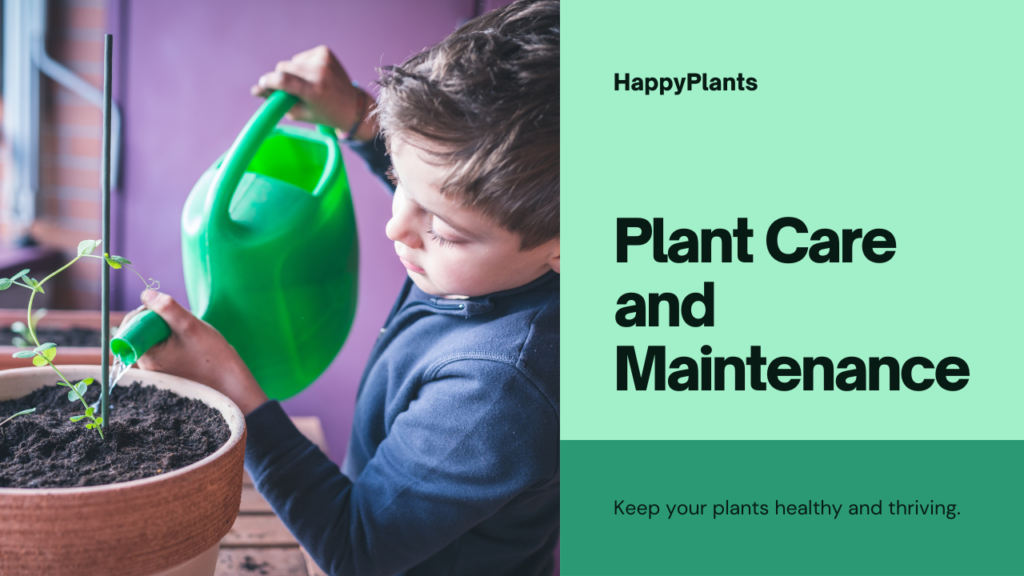
Proper plant care and maintenance are essential for the health and vitality of your container gardens. Implementing effective watering techniques, fertilizing methods, and pruning techniques will help ensure that your plants thrive and flourish. Read on to discover helpful tips for maintaining your container gardens.
Watering Techniques
Watering your plants correctly is crucial for their well-being. The frequency and amount of water needed vary depending on several factors, such as the type of plant, container size, and environmental conditions. As a general guideline, ensure that the soil is moist but not overly saturated. A simple way to test moisture levels is to stick your finger about an inch into the soil. If it feels dry, it’s time to water your plants.
Fertilizing Methods
Fertilizing your container gardens provides essential nutrients that promote healthy growth and vibrant blooms. Choose a high-quality, well-balanced fertilizer specifically formulated for container plants. Follow the instructions on the fertilizer packaging for proper application and dosage. Remember to adjust the fertilization schedule based on your plants’ needs and the specific recommendations for each type of plant.
Pruning Techniques
Pruning is a vital part of plant care as it helps maintain the desired shape, removes dead or damaged foliage, and stimulates healthy growth. Regular pruning encourages the production of more flowers and enhances the overall appearance of your container gardens. Use clean, sharp pruning shears and remove any unruly or overcrowded branches. Be mindful not to prune excessively, as this can harm the plant.
Tip: When pruning, it’s important to prioritize both aesthetics and plant health. Always prune just above a leaf node or a healthy bud to encourage proper growth.
To summarize, mastering watering techniques, fertilizing methods, and pruning techniques are key to successful plant care and maintenance in your container gardens. Implement these tips to create thriving and visually stunning displays in your outdoor or indoor spaces.
Common Pests and Diseases in Container Gardens
Container gardens can be susceptible to a variety of common pests and diseases, which can jeopardize the health and vitality of your plants. However, with the right knowledge and preventive measures, you can keep your container garden thriving and pest-free.
Pest Identification and Prevention
Identifying common pests in container gardens is crucial for effective prevention and control. Here are some of the most prevalent pests that you may encounter:
- Aphids: These small, soft-bodied insects feed on the sap of plants, causing stunted growth and distorted leaves.
- Spider mites: These tiny pests spin webs and suck the sap from leaves, leading to yellowing and wilting.
- Whiteflies: These small, flying insects damage plants by feeding on the underside of leaves and spreading diseases.
- Snails and slugs: These mollusks chew on leaves and stems, leaving behind slimy trails and holes in foliage.
To prevent pest infestations in your container garden, consider the following tips:
- Inspect plants: Before introducing new plants to your garden, carefully inspect them for signs of pests or disease.
- Maintain cleanliness: Regularly remove fallen leaves and debris from your garden to deter pests from taking up residence.
- Practice crop rotation: Avoid planting the same species in the same containers year after year to minimize the risk of pests and diseases building up in the soil.
- Encourage beneficial insects: Attract natural predators like ladybugs and lacewings that feed on common garden pests.
Disease Identification and Treatment
Diseases can also pose a threat to the health of your container plants. Here are a few common diseases to watch out for:
- Root rot: This fungal disease causes root decay, leading to unstable and unhealthy plants.
- Powdery mildew: This white, powdery fungus infects leaves and stems, hindering photosynthesis and weakening the plant.
- Botrytis blight: Also known as gray mold, this fungal disease causes grayish-brown patches on leaves and flowers.
If you notice signs of disease in your container garden, take action promptly using the appropriate treatment methods:
- Remove infected plant parts: Prune and dispose of any infected leaves, stems, or flowers to prevent the spread of disease.
- Apply fungicides: Use organic or chemical fungicides as recommended to combat fungal diseases and protect your plants.
- Improve airflow: Increase ventilation around your containers by spacing them adequately and removing any obstructions.
- Practice proper watering: Avoid over-watering, as excessive moisture can promote the growth of fungal diseases.
By staying vigilant and taking proactive measures, you can minimize the risk of pests and diseases damaging your container garden. Remember to regularly inspect your plants, maintain cleanliness in your garden, and promptly address any signs of trouble. With proper care and attention, your container garden will thrive and provide you with beautiful blooms and bountiful harvests.
Seasonal Considerations
When it comes to container gardening, seasonal plant care plays a crucial role in ensuring the health and thriving of your plants. By adapting your care routine to the changing seasons, you can provide the optimal conditions for your container garden to flourish. Additionally, preparing for extreme weather conditions is essential in safeguarding your plants from potential harm. Here are some tips to help you navigate seasonal variations and protect your container garden.
Adapting to Different Seasons
- Spring: As the weather warms up, it’s time to prepare your container garden for a season of growth. Increase watering frequency as plants become more active and adjust fertilization to support their nutritional needs.
- Summer: With the heat of summer, it’s crucial to provide adequate water to prevent plants from drying out. Consider mulching the soil surface to retain moisture and provide shade for sensitive plants.
- Fall: As temperatures begin to cool, reduce watering frequency to avoid waterlogging the soil. Focus on deadheading and removing any diseased or spent plants to keep your container garden tidy during this season.
- Winter: In colder regions, protecting your plants from frost is essential. Consider moving sensitive plants indoors or providing insulation using horticultural fleece or bubble wrap.
Preparing for Extreme Weather Conditions
“Extreme weather conditions such as heatwaves or frost can pose challenges to container gardens. By taking preemptive measures, you can minimize the impact of such events and help your plants survive and thrive.”
- Heatwaves: During heatwaves, it’s crucial to provide ample shade and protection for your plants. Consider placing them in a cooler location, providing shade cloths, or using reflective mulch to reduce heat absorption.
- Frost: When frost threatens, move frost-sensitive plants indoors or to a sheltered spot. Use horticultural fleece or covers to shield your plants from freezing temperatures.
Remember to monitor weather forecasts regularly and stay proactive in adjusting your care routine to accommodate extreme weather conditions. By considering seasonal changes and preparing for extreme weather, you can ensure that your container garden remains vibrant and healthy throughout the year.
Tips for Seasonal Plant Care and Changes
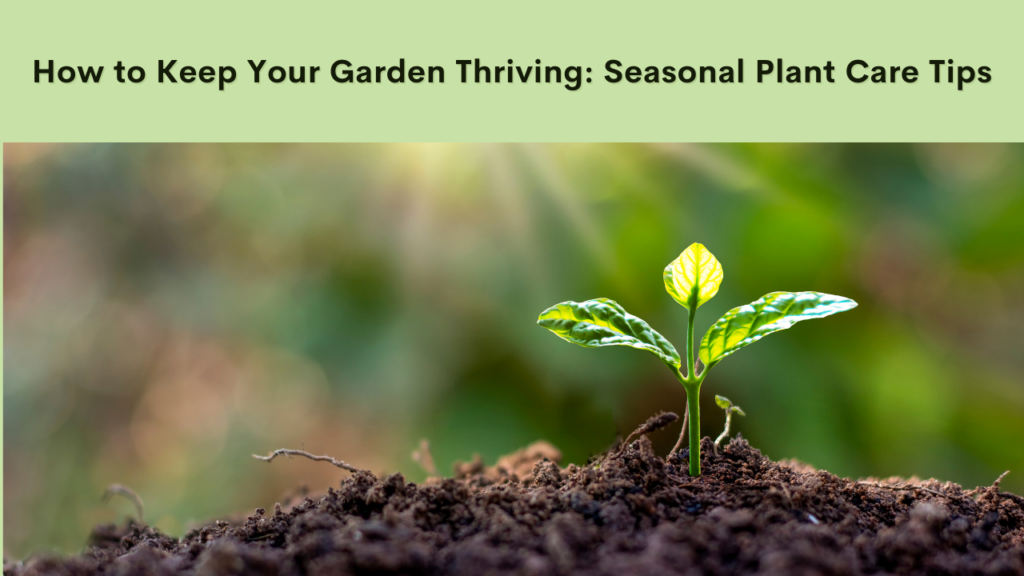
Proper seasonal plant care is essential for maintaining the health and vitality of your container garden throughout the year. Each season brings unique challenges and opportunities for growth, and by adjusting your care routine accordingly, you can ensure your plants thrive in any weather conditions.
Adjusting Watering Frequency
Watering is a crucial aspect of seasonal plant care. As the seasons change, so do the watering needs of your container plants. During hot summer months, plants may require more frequent watering to combat dehydration. However, in colder months, plants need less water as they enter a dormant state. Here are some general guidelines:
- In spring and summer, check the moisture levels of the soil regularly and water when the top inch feels dry.
- In fall and winter, reduce watering frequency and only water when the soil is dry at a depth of one to two inches.
Adapting Fertilization Schedules
Fertilizing your container plants appropriately throughout the seasons provides them with essential nutrients for growth and blooming. Consider the following tips:
- In spring, when your plants start growing actively, apply a slow-release, balanced fertilizer to support healthy foliage and root development.
- In summer, continue fertilizing every 4 to 6 weeks to sustain plant growth and enhance flower production.
- In fall, reduce or stop fertilizing as plants prepare for dormancy.
- In winter, avoid fertilization as it may promote growth during an unfavorable time.
Protecting Plants from Weather Changes
Extreme weather conditions can pose challenges to your container garden’s health. Protect your plants with the following measures:
- In hot summers, provide shade or move heat-sensitive plants to a sheltered spot to prevent wilting and sunburn.
- In freezing winters, protect plants from frost by covering them with a breathable fabric or relocating them indoors temporarily.
Remember, every plant has unique care needs, so it’s essential to research the specific requirements of each plant in your container garden.
By applying these tips for seasonal plant care and changes, you can optimize the health and beauty of your container garden throughout the year.
FAQ
Q. Why is maintaining container gardens important?
A. Maintaining container gardens is important to ensure the health and vitality of the plants. Proper care supports their growth, prevents diseases, and prolongs their lifespan.
Q. What are the benefits of container gardening?
A. Container gardening offers several benefits such as flexibility in gardening, the ability to garden in limited spaces, and the opportunity to create beautiful arrangements that can be easily moved.
Q. How do I choose the right containers for my plants?
A. When selecting containers, consider the type of plant, its root system, and the available space. Choose the appropriate size and material, such as clay pots for plants that require good drainage or plastic containers for moisture-loving plants.
Q. What is the importance of quality soil in container gardening?
A. Quality soil is essential for container gardening as it provides the necessary nutrients, proper drainage, and aeration for the plants’ roots. It ensures healthy plant growth and reduces the risk of root rot and other soil-related issues.
Q. How do I prepare healthy soil for my containers?
A. Start by selecting a well-draining potting mix suitable for your plants. Prior to planting, remove any debris or weeds and amend the soil with organic matter. Regularly monitor the soil moisture levels and adjust as needed.
Q. What are some tips for watering container gardens?
A. Water container gardens thoroughly, ensuring that water reaches all parts of the root system. Avoid overwatering and allow the soil to slightly dry out between waterings. Mulching the soil surface can help retain moisture.
Q. How do I fertilize plants in container gardens?
A. Use a balanced fertilizer specifically formulated for container plants. Follow the instructions on the fertilizer packaging and apply it according to the recommended schedule. Avoid applying excessive amounts of fertilizer, as it can harm the plants.
Q. What pruning techniques should I use for container plants?
A. Regularly prune container plants to promote healthy growth and maintain their shape. Remove dead or overgrown parts, and pinch back or trim branches to encourage bushiness. Be mindful of the specific pruning requirements of different plant species.
Q. What are some common pests and diseases in container gardens?
A. Common pests in container gardens include aphids, mealybugs, and spider mites. Diseases like powdery mildew and root rot can also affect container plants. Regularly inspect your plants for signs of infestation or disease and take appropriate measures to control and prevent them.
Q. How should I adapt my plant care routine for different seasons?
A. Adjust your watering frequency and amount, fertilization schedule, and pruning practices to align with seasonal changes. Consider factors such as temperature, humidity, and daylight hours to provide the best care for your container plants.
Q. How can I prepare my container plants for extreme weather conditions?
A. Pay attention to weather forecasts and take precautions to protect your plants from extreme weather. Provide shade or move containers indoors during heatwaves and use frost protection measures during cold spells. Adequate watering is also essential during periods of high heat.
Conclusion
Congratulations on your journey to maintaining a thriving container garden! By following these key maintenance tips, you can ensure that your plants thrive and bring beauty to your outdoor space.
Remember, selecting the right containers for your plants is essential. Consider the size, material, and drainage capabilities to provide the best growing environment. Equally important is choosing quality soil that provides proper nutrition and drainage.
Regular plant care and maintenance, including proper watering techniques, fertilizing, and pruning, will keep your container garden healthy and vibrant. Keep an eye out for common pests and diseases, and take preventive measures to protect your plants.
If you want to dig deeper into container garden maintenance, there are additional resources available. Check out books, online articles, and gardening forums for further information and expert advice on maintaining container gardens. With the right knowledge and care, your container garden will flourish for years to come.


